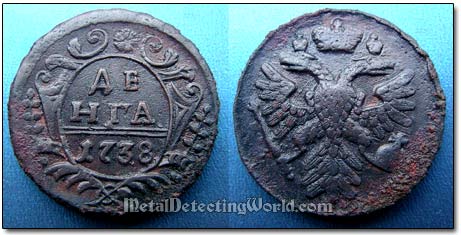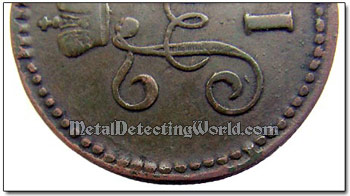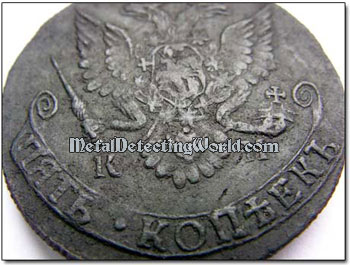Cleaning and Preservation of Coins - A Complete Guide, page 23
ARTIFICIAL PATINATION of COPPER, ZINC and IRON COINS
HOW TO PATINATE COPPER COINS in 9 Desirable Color Tones
True patina and its origin are described on page 3. Both true patina and artificial patina protect the copper and copper alloys against the external influences, and give the copper coins and relics aesthetic appearance.
NOTE: Before the patination, the coin metal surface must be degreased, thoroughly washed and dried.
During the process of patination, the patinating solution slightly smoothes the coin's micro relief by dissolving the surface layer of the coin's metal which is replaced with a thin film of cuprous oxide. That is why a great care must be exercised here.
Artificial patinas are not stable under the influence of air and, therefore, should be protected by the lacquer, wax or oils. However, these organic coatings do not last long, and after their disintegration begins, new centers of the unequally changing patina appear.
Generally the sulfur-containing compounds are used for tarnishing the copper-base alloyed coins and relics. As for artificial patination, use of various soluble mixtures of these sulfur-containing compounds with other substances allows to patinate coins in a number of colors that are characteristic for aged copper.
The following methods, not widely known, are used for patinating copper, bronze and brass coins in nine desirable colors:
1) Gold-Brown Patina
This patina has a gold-like brown color with a slight tone of pink and a moderate luster. 20 grams of Copper Sulphate Pentahydrate (CuSO4·5H2O) and 5 grams of Potassium Permanganate (KMnO4) are dissolved in 1 liter of water of the room's temperature. The solution is applied with a brush to the coin. The coin is left for 24 hours, then rinsed with hot water and dried. The treatment is repeated 3-4 times. The surface can be polished with a soft cloth or special coin polishing cloth with anti-tarnish protection.
If the coin is boiled in this solution for more than 10 minutes, it gets a black-violet patina.
Appearance of Black-Violet Patina when Coin is Boiled Excessively

This method is illustrated in my tutorial - Simplified and Quick Method for Cleaning Copper Coins and Enhancing Their Designs' Appearance.
2) Olive Patina
50-70 g of Potassium Chlorate (KClO3), 40-50 g of Cupric Nitrate "Trihydrate" (Cu(NO3)2) and 80-100 g of Ammonium Chloride (NH4Cl) are dissolved in 1 litre of water. The coins are immersed into this solution, heated up to 149°F (65°C), for 10-15 minutes. The resulting patina is strong and resistant to corrosion.
3) Green Two-Layer Patina
This method involves two solutions. Solution 1 is prepared by dissolving 100g of Ammonium Sulphate ((NH4)2SO4) in 1 liter of water. Solution 2 is prepared by dissolving 50g of Copper Sulphate 5-hydrat (CuSO45H2O), 10g of Sodium Hydroxide (NaOH, also known as lye or caustic soda) and 176g of Ammonium Hydroxide (NH4OH) in 1 liter of water.
First, the coin's surface is washed by the solution 1 two or three times, followed by rinsing and drying each time. Then the coin with brown-yellowish film is brushed with the solution 2, twice a day for 4-5 days, followed by rinsing with cold water each time. The newly made blue patina gradually turns green in the open air and becomes very resistant to it.
4) "Old Bronze" (Dark Olive) Patina

200g of Cupric Nitrate "Trihydrate" (Cu(NO3)2), 8g of Silver Nitrate (AgNO3) and 6.5ml of Nitric acid (HNO3) are dissolved in 1 liter of water. The coin is brushed with this solution, and left until its surface is dried. Then the salts formed on the coin's surface are cleaned off with a tattered cloth. The process is repeated again. The dark-olive patina appears in 10-12 days.
The great care must be exercised with use of Nitric acid if the zinc-contained copper alloys are involved in the treatment. Such alloys might slightly change their metal structure on the surface after having been treated.
5) Additional Five Colors of Patina
Formation of the next five color tones of patina depends on how long the coin is immersed in the mixture of the following two solutions. Solution 1 is prepared by dissolving 45g of Sodium Bisulfite (NaHSO3) in 500ml of water. Solution 2 is prepared by dissolving 15g of Copper Sulphate 5-hydrat (CuSO45H2O) in 500ml of water. The solutions are mixed together and heated up to the boiling point. The coin is immersed into the boiling solution, and the patination begins immediately:
• "Old Gold" Patina appears in 5-10 seconds.
• Dark Purple Patina appears in 12-15 seconds.
• Purple-Violet Patina appears in 16-18 seconds.
• Violet-Gray Patina appears in 19-22 seconds.
• Black Patina appears in 25 seconds - 2 minutes.
Black Patina

After a desirable tone of patina has been obtained, the coin is immediately taken out of solution, rinsed and dried. The precipitated salts are cleaned off the coin's surface, and the rinsing and drying follow.
You can immerse the coin into the solution just for a few seconds, then rinse it, and immerse it into the hot solution again. This technique will allow you to control the process and not overdo it, thus obtaining the exact tone of the coin patina desired.
HOW TO TARNISH ZINC COINS
Zinc coins that have become too bright through cleaning can be treated in the same way by Potassium Sulfide or Sulfur methods described above.
HOW TO TARNISH IRON COINS
The iron coins can be tarnished by blackening with Iron Varnish thinned with Acetone.